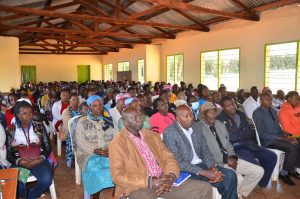Grade 7 learners in over 2,000 Junior Secondary Schools (JSS) across the central region will have all the 12 text books before the end of March, Central Region Director of Education Sabina Aroni has said.
She noted that a majority of the schools had already received books for five core learning areas with the remaining seven expected to be delivered in two weeks’ time.
“We are working with different distributors each dealing with a county. Books for five learning areas (subjects) have already been released to both public and private junior secondary schools across the central region and the other seven will equally be distributed before the end of March,” said Aroni.
Aroni who was speaking in Gikanja primary and junior secondary school during a parents’ sensitization forum on the Competency Based Curriculum by Ministry of Education officials, also sought to clarify that the Teachers Service Commission (TSC) was deploying JSS tutors based on the number of streams hosted by the respective primary school.

Photos By Wangari Mwangi
In Nyeri a total of 75 JSS tutors were deployed by the teachers’ employer against a total of 344 public Junior Secondary Schools registered in the county. To cover the shortfall, Aroni challenged school heads to make use of the experienced teachers already working in the school to ease the workload for the newly recruited JSS teacher as they wait for TSC to hire and deploy additional tutors for JSS.
“The TSC was deploying teachers based on the number of streams available in the JSS so if the school had a single stream, one teacher was deployed and if it had three then the school got three tutors. Since the school already has experienced teachers who have been teaching standard seven and eight pupils, we are encouraging the heads to assign them to JSS so as to complement these JSS teachers,” she said.
Aroni who was accompanied by Nyeri Deputy County Commissioner, Joseph Mwangi, Central Region Director of Education Dr Peter Munene and host of ministry of education officials, has at the same time reassured parents that the government had put in place strategies to resolve any emerging issues affecting the full implementation of the new curriculum.
“These children are in safe hands, the government has put in place all the required strategies and plans to ensure that the products of CBC, who have come all the way from Grade One, are successful.
The region which comprises Kiambu, Kirinyaga, Murang’a, Nyandarua and Nyeri Counties has a total of 2,497 Junior Secondary schools. Out of these 1,750 are public while 747 are private schools.
On the issue of capitation, the region’s Director of Education, Dr Peter Munene, said that JSS in the region should expect capitation by the end of this week. He said that a majority of the schools in the region had already complied with the ministry’s circular directing them to open separate bank accounts for JSS sections.
“Most schools hosting JSS spent the better part of last week opening bank accounts. There had been a delay in releasing the funds because not all schools had managed to open these accounts. We have been given the reassurance that the money from the national government will have been disbursed to the schools by the end of this week,” said Dr Munene.
Schools are set to receive Sh 9.6 billion as first term capitation for Grade 7 learners. Each JSS learner has been allocated an annual capitation of Sh 15,000 which will be released in three instalments of 50 per cent, 30 per cent and 20 per cent.




